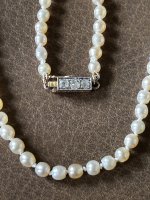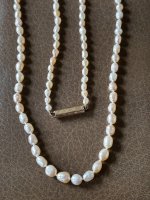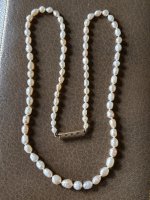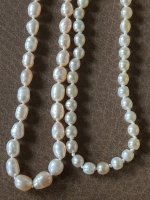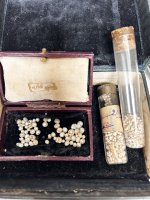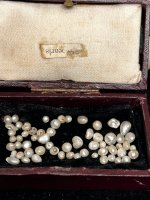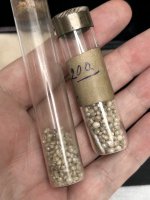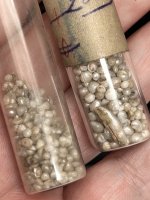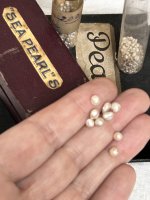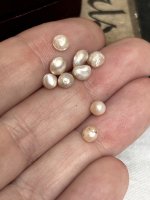This set of pictures contains images of two antique necklaces. The first is set on an 18ct gold clasp with three fine diamonds and French hallmarks. The pearls on this necklace are natural saltwater pearls with a slight barrel shape and averaging about 5mm in length. They are a cream colour with the expected variations you’d see in a natural string.
The second necklace is a mystery! Again strung on a gold clasp of French design, but older. The pearls are slightly larger (around 6mm in length) and more varied in shape with a very high lustre and pink overtones. I’ve photographed both necklaces together for comparison with the known natural pearls. Dental X-rays show similar patterns for both with no evidence of bead nucleation and I drilled one bead in half to take a look inside but I’m not trained in identification of tissue-nucleated pearls. I wondered if anyone more knowledgeable might be able to comment? My sincere thanks in advance. Catherine (a newbie here, but a long term lurker!)

The second necklace is a mystery! Again strung on a gold clasp of French design, but older. The pearls are slightly larger (around 6mm in length) and more varied in shape with a very high lustre and pink overtones. I’ve photographed both necklaces together for comparison with the known natural pearls. Dental X-rays show similar patterns for both with no evidence of bead nucleation and I drilled one bead in half to take a look inside but I’m not trained in identification of tissue-nucleated pearls. I wondered if anyone more knowledgeable might be able to comment? My sincere thanks in advance. Catherine (a newbie here, but a long term lurker!)

